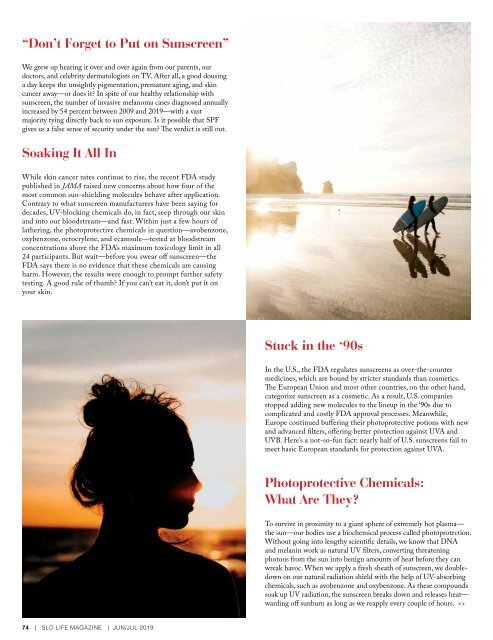You also want an ePaper? Increase the reach of your titles
YUMPU automatically turns print PDFs into web optimized ePapers that Google loves.
“Don’t Forget to Put on Sunscreen”<br />
We grew up hearing it over and over again from our parents, our<br />
doctors, and celebrity dermatologists on TV. After all, a good dousing<br />
a day keeps the unsightly pigmentation, premature aging, and skin<br />
cancer away—or does it? In spite of our healthy relationship with<br />
sunscreen, the number of invasive melanoma cases diagnosed annually<br />
increased by 54 percent between 2009 and <strong>2019</strong>—with a vast<br />
majority tying directly back to sun exposure. Is it possible that SPF<br />
gives us a false sense of security under the sun? The verdict is still out.<br />
Soaking It All In<br />
While skin cancer rates continue to rise, the recent FDA study<br />
published in JAMA raised new concerns about how four of the<br />
most common sun-shielding molecules behave after application.<br />
Contrary to what sunscreen manufacturers have been saying for<br />
decades, UV-blocking chemicals do, in fact, seep through our skin<br />
and into our bloodstream—and fast. Within just a few hours of<br />
lathering, the photoprotective chemicals in question—avobenzone,<br />
oxybenzone, octocrylene, and ecamsule—tested at bloodstream<br />
concentrations above the FDA’s maximum toxicology limit in all<br />
24 participants. But wait—before you swear off sunscreen—the<br />
FDA says there is no evidence that these chemicals are causing<br />
harm. However, the results were enough to prompt further safety<br />
testing. A good rule of thumb? If you can’t eat it, don’t put it on<br />
your skin.<br />
Stuck in the ‘90s<br />
In the U.S., the FDA regulates sunscreens as over-the-counter<br />
medicines, which are bound by stricter standards than cosmetics.<br />
The European Union and most other countries, on the other hand,<br />
categorize sunscreen as a cosmetic. As a result, U.S. companies<br />
stopped adding new molecules to the lineup in the ‘90s due to<br />
complicated and costly FDA approval processes. Meanwhile,<br />
Europe continued buffering their photoprotective potions with new<br />
and advanced filters, offering better protection against UVA and<br />
UVB. Here’s a not-so-fun fact: nearly half of U.S. sunscreens fail to<br />
meet basic European standards for protection against UVA.<br />
Photoprotective Chemicals:<br />
What Are They?<br />
To survive in proximity to a giant sphere of extremely hot plasma—<br />
the sun—our bodies use a biochemical process called photoprotection.<br />
Without going into lengthy scientific details, we know that DNA<br />
and melanin work as natural UV filters, converting threatening<br />
photons from the sun into benign amounts of heat before they can<br />
wreak havoc. When we apply a fresh sheath of sunscreen, we doubledown<br />
on our natural radiation shield with the help of UV-absorbing<br />
chemicals, such as avobenzone and oxybenzone. As these compounds<br />
soak up UV radiation, the sunscreen breaks down and releases heat—<br />
warding off sunburn as long as we reapply every couple of hours. >><br />
74 | <strong>SLO</strong> <strong>LIFE</strong> MAGAZINE | JUN/JUL <strong>2019</strong>


















